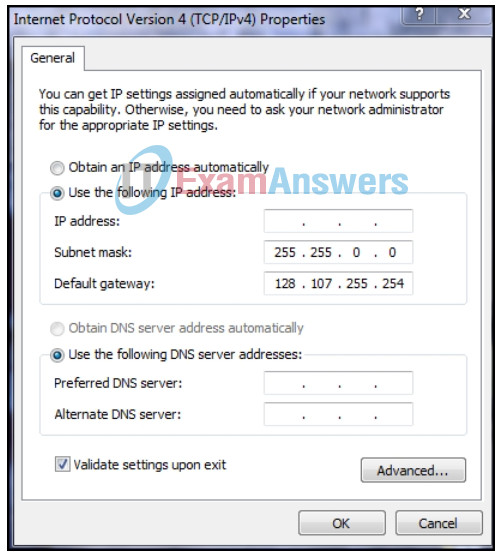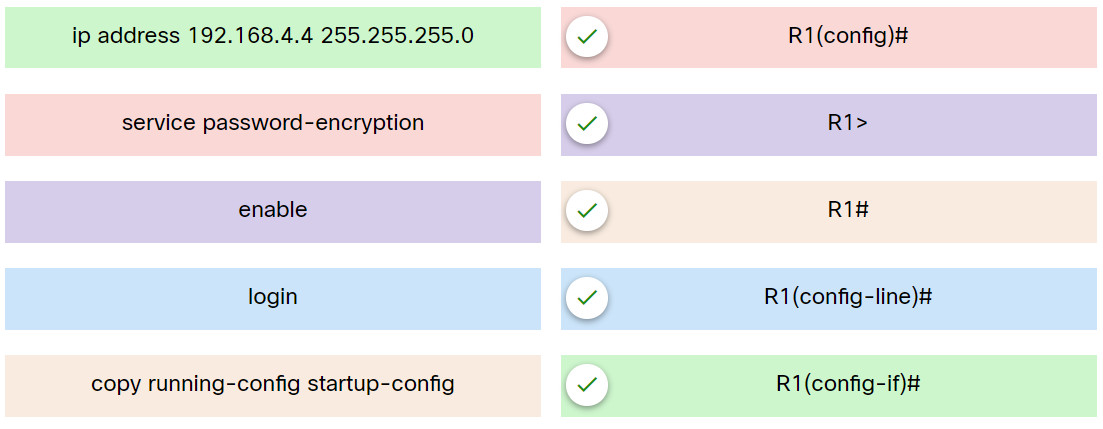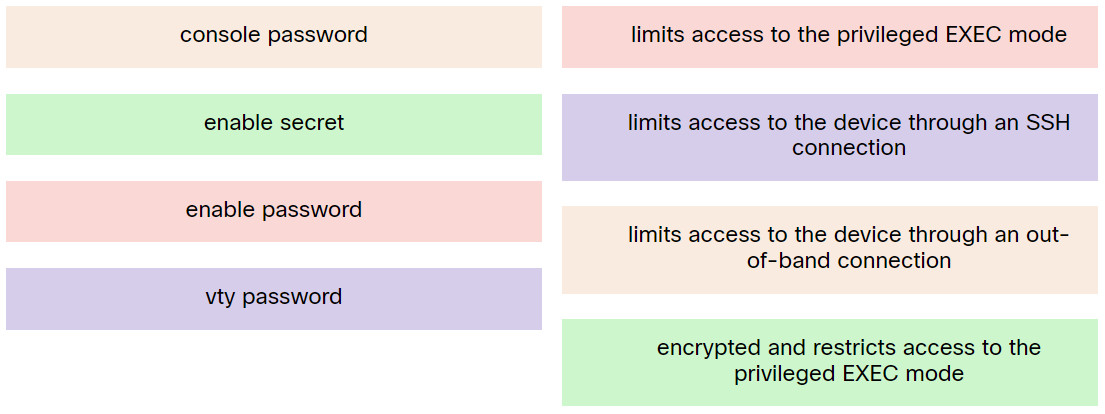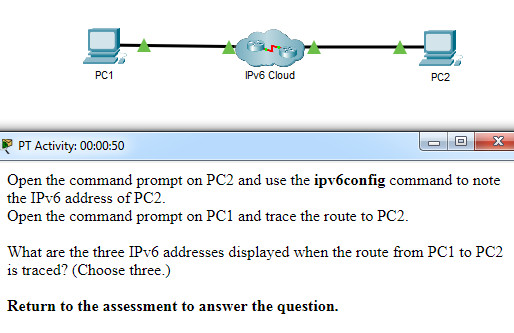Networking Devices and Initial Configuration Checkpoint Exam: Configure Cisco Devices Answers
1. Which Cisco IOS mode displays a prompt of Router#?
- user EXEC mode
- setup mode
- privileged EXEC mode
- global configuration mode
Explanation: Cisco IOS uses different command modes for operational needs. The privileged EXEC mode is identified by a prompt that ends with the # symbol after the device name. The user EXEC mode is identified by a prompt that ends with the > symbol after the device name. The global configuration mode is identified by a prompt that ends with (config)# after the device name.
2. Refer to the exhibit. An administrator is trying to configure the switch but receives the error message that is displayed in the exhibit. What is the problem?

- The administrator must first enter privileged EXEC mode before issuing the command.
- The entire command, configure terminal, must be used.
- The administrator must connect via the console port to access global configuration mode.
- The administrator is already in global configuration mode.
Explanation: In order to enter global configuration mode, the command configure terminal, or a shortened version such as config t, must be entered from privileged EXEC mode. In this scenario the administrator is in user EXEC mode, as indicated by the > symbol after the hostname. The administrator would need to use the enable command to move into privileged EXEC mode before entering the configure terminal command.
3. Which switch command would a network administrator use to determine if there are encapsulation or media errors on an interface?
- show ip interface
- show arp
- show interfaces
- show line
Explanation: The show interfaces command is useful to detect media errors, to see if packets are being sent and received, and to determine if any runts, giants, CRCs, interface resets, or other errors have occurred. The show ip interface command is useful in seeing whether the interface is “up and up”. The output of the show line command displays parameters for active lines that are in use such as the vty line used for Telnet. The show arp command shows the contents of the Address Resolution Protocol (ARP) table.
4. To save time, IOS commands may be partially entered and then completed by typing which key or key combination?
- Ctrl-N
- Down Arrow
- Tab
- Ctrl-P
- Right Arrow
- Up Arrow
Explanation: The IOS CLI provides hot keys and shortcuts that make configuring, monitoring, and troubleshooting easier. Some keys or key combinations shift between characters and entire commands. The tab key is used to complete a command that has been partially entered into the command line.
5. An administrator uses the Ctrl-Shift-6 key combination on a switch after issuing the ping command. What is the purpose of using these keystrokes?
- to exit to a different configuration mode
- to allow the user to complete the command
- to restart the ping process
- to interrupt the ping process
Explanation: To interrupt an IOS process such as ping or traceroute, a user enters the Ctrl-Shift-6 key combination. Tab completes the remainder of parameters or arguments within a command. To exit from configuration mode to privileged mode use the Ctrl-Z keystroke. CTRL-R will redisplay the line just typed, thus making it easier for the user to press Enter and reissue the ping command.
6. Refer to the exhibit. Which element of IOS syntax is the expression MainOffice?

- an argument
- a subcommand
- a command
- a keyword
Explanation: An argument of a CLI command is generally not a predefined word, but rather is a value defined by the user. Keywords, however, describe specific parameters of a command that are predefined words that are known to the command interpreter.
7. What does the letter C mean next to an entry in the output of the show ip route command?
- It identifies a network that is learned through EIGRP.
- It identifies a network that is learned through OSPF.
- It identifies a network that is directly connected to the router.
- It identifies a network that is a static route.
Explanation: In a routing table, the label C identifies a network that is directly connected to an interface on the device. This entry is added to the routing table when an interface is configured with an IP address and activated.
8. Which interface is the default SVI on a Cisco switch?
- VLAN 1
- VLAN 99
- FastEthernet 0/1
- GigabitEthernet 0/1
Explanation: An SVI is a virtual interface and VLAN 1 is enabled by default on Cisco switches. VLAN 99 must be configured to be used. FastEthernet 0/1 and GigabitEthernet 0/1 are physical interfaces.
9. A network administrator enters the service password-encryption command into the configuration mode of a router. What does this command accomplish?
- This command provides an exclusive encrypted password for external service personnel who are required to do router maintenance.
- This command automatically encrypts passwords in configuration files that are currently stored in NVRAM.
- This command encrypts passwords as they are transmitted across serial WAN links.
- This command prevents someone from viewing the running configuration passwords.
- This command enables a strong encryption algorithm for the enable secret password command.
Explanation: The startup-config and running-config files display most passwords in plaintext. Use the service password-encryption global config command to encrypt all plaintext passwords in these files.
10. Refer to the exhibit. A network technician is statically assigning an IP address to a PC. The default gateway is correct. What would be a valid IP address to assign to the host?

Networking Devices and Initial Configuration Module 10 – 12 Checkpoint Exam 10
- 128.107.255.1
- 128.108.100.10
- 128.106.10.100
- 128.107.255.254
Explanation: In data communication, the default gateway device is involved only when a host needs to communicate with other hosts on another network. The default gateway address identifies a network device used by hosts to communicate with devices on remote networks. The IP address of the host and the default gateway address must be in the same network. With the default subnet mask, valid host IP addresses range from 128.107.0.1 to 128.107.255.254.
11. When configuring SSH on a router to implement secure network management, a network engineer has issued the login local and transport input ssh line vty commands. What three additional configuration actions have to be performed to complete the SSH configuration? (Choose three.)
- Create a valid local username and password database.
- Configure the correct IP domain name.
- Configure role-based CLI access.
- Generate the asymmetric RSA keys.
- Set the user privilege levels.
- Manually enable SSH after the RSA keys are generated.
Explanation: SSH is automatically enabled after the RSA keys are generated. Setting user privilege levels and configuring role-based CLI access are good security practices but are not a requirement of implementing SSH.
12. Match the command with the device mode at which the command is entered.

Explanation: Place the options in the following order:
| service password-encryption |
R1(config)# |
| enable |
R1> |
| copy running-config startup-config |
R1# |
| login |
R1(config-line)# |
| ip address 192.168.4.4 255.255.255.0 |
R1(config-if)# |
13. Passwords can be used to restrict access to all or parts of the Cisco IOS. Select the modes and interfaces that can be protected with passwords. (Choose three.)
- privileged EXEC mode
- router configuration mode
- VTY interface
- Ethernet interface
- console interface
- boot IOS mode
Explanation: Access to the VTY and console interfaces can be restricted using passwords. Out-of-band management of the router can be restricted in both user EXEC and privileged EXEC modes.
14. Match the type of password on a Cisco device to the function.

Explanation: Place the options in the following order:
| enable password |
limits access to the privileged EXEC mode |
| vty password |
limits access to the device through an SSH connection |
| console password |
limits access to the device through an out-of-band connection |
| enable secret |
encrypted and restricts access to the privileged EXEC mode |
15. What is the purpose of ICMP messages?
- to monitor the process of a domain name to IP address resolution
- to provide feedback of IP packet transmissions
- to ensure the delivery of an IP packet
- to inform routers about network topology changes
Explanation: The purpose of ICMP messages is to provide feedback about issues that are related to the processing of IP packets.
16. Open the PT Activity. Perform the tasks in the activity instructions and then answer the question. What are the three IPv6 addresses displayed when the route from PC1 to PC2 is traced? (Choose three.)

- 2001:DB8:1:4::1
- 2001:DB8:1:2::2
- 2001:DB8:1:2::1
- 2001:DB8:1:1::A
- 2001:DB8:1:3::1
- 2001:DB8:1:3::2
- 2001:DB8:1:1::1
Explanation: Using the ipv6config command on PC2 displays the IPv6 address of PC2, which is 2001:DB8:1:4::A. The IPV6 link-local address, FE80::260:70FF:FE34:6930, is not used in route tracing. Using the tracert 2001:DB8:1:4::A command on PC1 displays four addresses: 2001:DB8:1:1::1, 2001:DB8:1:2::1 , 2001:DB8:1:3::2, and 2001:DB8:1:4::A.
17. A user calls to report that a PC cannot access the internet. The network technician asks the user to issue the command ping 127.0.0.1 in a command prompt window. The user reports that the result is four positive replies. What conclusion can be drawn based on this connectivity test?
- The IP address obtained from the DHCP server is correct.
- The TCP/IP implementation is functional.
- The PC can access the Internet. However, the web browser may not work.
- The PC can access the network. The problem exists beyond the local network.
Explanation: The ping 127.0.0.1 command is used to verify that the TCP/IP stack is functional. It verifies the proper operation of the protocol stack from the network layer to physical layer, without sending a signal on the media. That is, this test does not go beyond the PC itself. For example, it does not detect whether a cable is connected to the PC or not.
18. Which utility uses the Internet Control Messaging Protocol (ICMP)?
Explanation: ICMP is used by network devices to send error messages.
19. A user issues a ping 198.51.100.5 command and receives a response that includes a code of 3. What does this code represent?
- network unreachable
- host unreachable
- port unreachable
- protocol unreachable
Explanation: When a host or gateway receives a packet that it cannot deliver, it can use an ICMP Destination Unreachable message to notify the source that the destination or service is unreachable. The message will include a code that indicates why the packet could not be delivered. These are some of the Destination Unreachable codes for ICMPv4:
0 : net unreachable
1 : host unreachable
2 : protocol unreachable
3 : port unreachable
20. Which ICMPv6 message is sent when the IPv6 hop limit field of a packet is decremented to zero and the packet cannot be forwarded?
- protocol unreachable
- time exceeded
- network unreachable
- port unreachable
Explanation: ICMPv6 uses the hop limit field in the IPv6 packet header to determine if the packet has expired. If the hop limit field has reached zero, a router will send a time exceeded message back towards the source indicating that the router cannot forward the packet.
21. Which command can be used to verify connectivity between two host devices?
- ping
- ipconfig
- netstat
- nslookup
Explanation: The ping command can be used to test end-to-end connectivity between two host devices. It measures the round-trip time for a message to get from source to destination.
22. A network administrator establishes a connection to a switch via SSH. What characteristic uniquely describes the SSH connection?
- direct access to the switch through the use of a terminal emulation program
- remote access to the switch through the use of a telephone dialup connection
- on-site access to a switch through the use of a directly connected PC and a console cable
- out-of-band access to a switch through the use of a virtual terminal with password authentication
- remote access to a switch where data is encrypted during the session
Explanation: SSH provides a secure remote login through a virtual interface. SSH provides a stronger password authentication than Telnet. SSH also encrypts the data during the session.
23. Which ICMP message is used by the traceroute utility during the process of finding the path between two end hosts?
- destination unreachable
- ping
- redirect
- time exceeded
Explanation: Traceroute progressively increments the TTL (IPv4) or hop limit (IPv6) field (1, 2, 3, 4…) for sending sequence of ping commands. When a router senses that the TTL or hop limit is 0, it will discard the packet and send a time exceeded message to the source of the traceroute. The returned message contains the IP address of the router that discarded the packet. Hence the traceroute utility learns the address of the router. This process continues and provides the trace with the address of each hop (router) as the packets continue traveling through routers to reach the destination.






